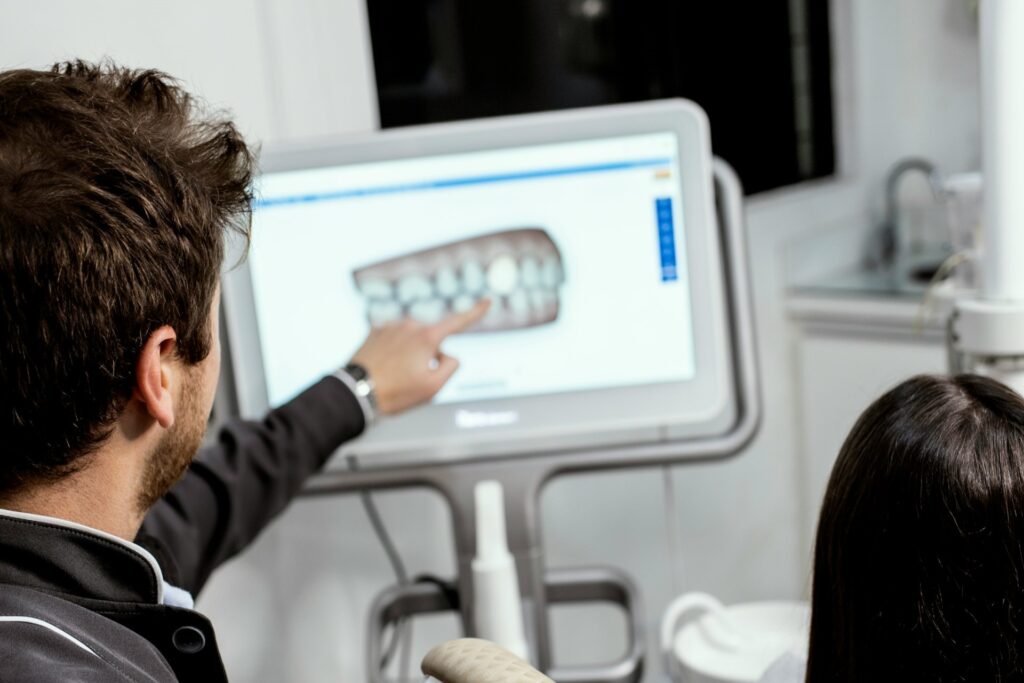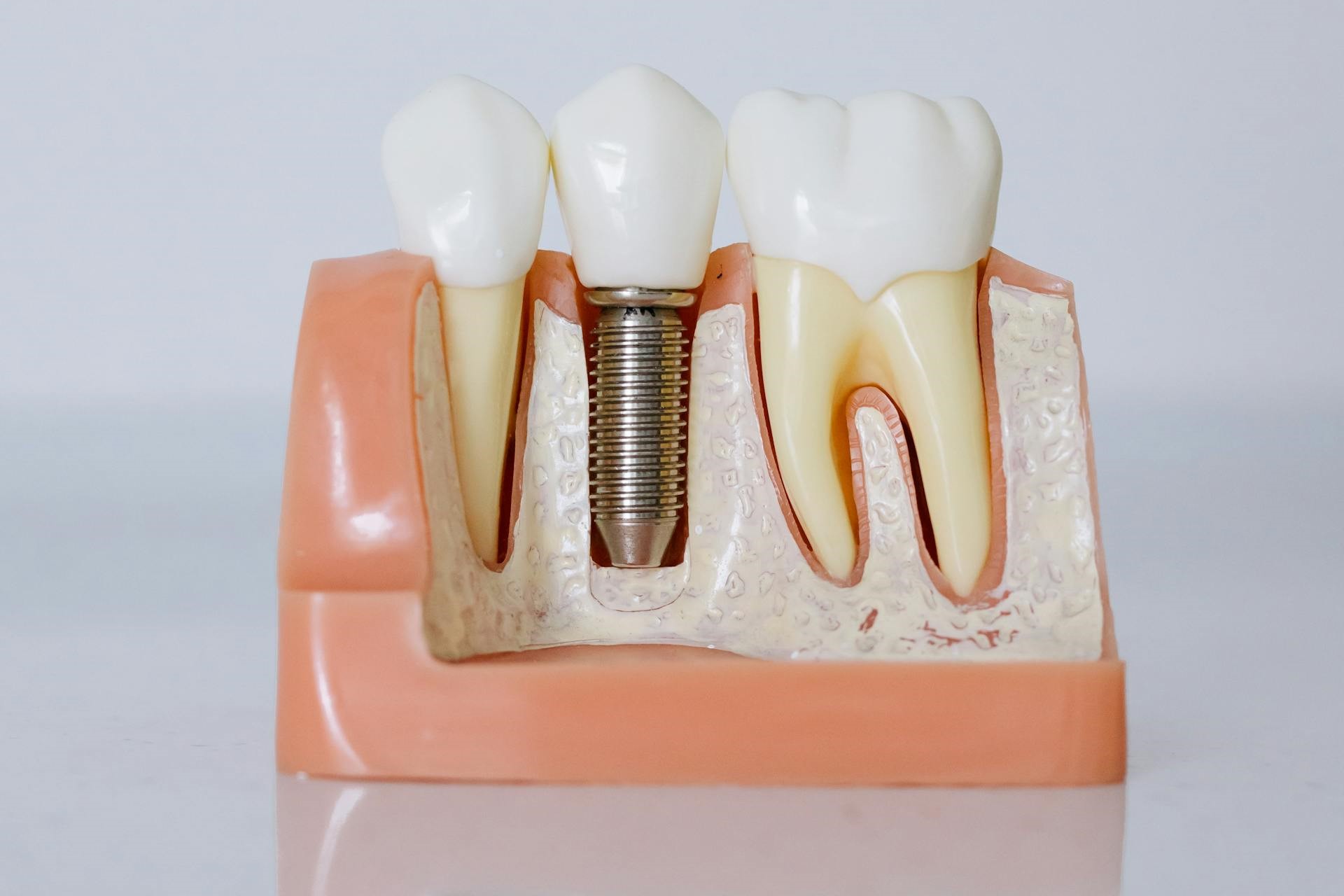
Dental implants have significantly changed the way we think about tooth replacement, providing a long-lasting and visually appealing option for individuals who have lost teeth.
This article delves into the specifics of dental implants, explaining how they function, outlining their benefits, and describing the different types that are available. It also covers the question, “Can dental implants be used to replace multiple teeth?”, the process involved in getting them, what to expect during recovery, potential risks, and important care tips to ensure their longevity.
Discover how dental implants can not only improve your smile but also boost your confidence!
What Are Dental Implants?

Dental implants are sophisticated dental solutions intended to offer a permanent remedy for those facing tooth loss, leading to considerable enhancements in oral health and functionality.
Typically crafted from titanium, these implants function as artificial tooth roots, securely anchored into the jawbone. This secure placement enables them to integrate seamlessly with the bone through a process known as osseointegration.
The journey to obtaining dental implants involves several key stages, starting with an initial consultation where specialists evaluate the patient’s dental needs and develop a customised treatment plan. This careful planning ensures the best possible outcomes for both aesthetic appeal and functional restoration.
How Do Dental Implants Work?
Dental implants function by utilising titanium posts that are surgically inserted into the jawbone. These posts act as anchors for prosthetics, such as crowns or dentures, providing a stable and durable solution for tooth replacement.
The success of the implant procedure is largely dependent on a process known as osseointegration. During this process, the titanium integrates with the bone, offering the necessary support for chewing efficiency and proper bite function. Advances in modern dental technology have significantly improved this integration process, allowing dental specialists to achieve excellent clinical outcomes and high levels of patient satisfaction.
The integration of the implant with the bone is crucial, as it directly impacts the longevity and effectiveness of the implants. For individuals considering this transformative dental option, having adequate bone density is essential, as it influences how well the implants will bond with the jawbone. In cases where bone density is insufficient, complications may arise, leading to the need for additional procedures such as bone grafting.
Beyond restoring the functionality of the mouth, dental implants also play a significant role in overall health by preventing bone loss and maintaining facial structure. As a result, patients frequently experience improved oral hygiene and enhanced aesthetics, making dental implants an appealing choice for many seeking reliable options for tooth replacement.
What Are the Benefits of Dental Implants?
Dental implants provide a range of benefits that can greatly improve both oral health and the overall quality of life for those experiencing tooth loss.
One of the main advantages is their effectiveness in replacing multiple teeth, offering a durable solution compared to traditional alternatives such as removable dentures or dental bridges.
Plus enhancing bite function and chewing efficiency, dental implants help maintain jawbone density and gum health. This, in turn, supports aesthetic dentistry and significantly boosts patient confidence and satisfaction.
1. Improved Appearance and Confidence
One of the most significant advantages of dental implants lies in their ability to enhance appearance and boost confidence. These implants are designed to closely resemble natural teeth in both shape and colour. This approach to aesthetic dentistry allows patients to enjoy a beautiful smile, free from the concerns that accompany visible gaps caused by tooth loss. As a result, many experience increased satisfaction and improved social interactions.
When individuals feel confident about their smiles, they often notice a positive shift in their demeanour, leading to enhanced social engagement and a greater sense of self-worth. The natural look and feel of dental implants not only restore functionality but also contribute to positive patient experiences, allowing individuals to participate in conversations without feeling self-conscious.
Research indicates that improved oral aesthetics can significantly reduce anxiety related to personal interactions, fostering a more optimistic outlook on life. For many people, the journey to reclaiming a stunning smile can also translate into enhanced emotional well-being, highlighting the profound psychological benefits associated with successful dental restoration.
2. Better Functionality of Teeth
Dental implants offer enhanced functionality compared to traditional tooth replacement options, allowing patients to experience a full range of motion in their bite and improved chewing efficiency. This long-term solution enables individuals to enjoy a varied diet without the limitations often encountered with removable dentures or fixed bridges, thereby supporting better overall health and nutrition.
By closely resembling the roots of natural teeth, these implants provide significant stability, making it easier for individuals to bite into tougher foods like apples or steak—foods that many might choose to avoid with less secure alternatives. The confidence that accompanies a stable bite can positively impact social interactions, encouraging individuals to dine out more frequently with friends and family.
This level of comfort not only enhances quality of life but also fosters healthier eating habits. Patients can incorporate a broader range of nutrients into their meals, give the power toing them to maintain optimal long-term health.
3. Long-lasting Solution
One of the key advantages of dental implants is their impressive durability, offering a long-lasting solution that frequently surpasses other tooth replacement options, such as removable dentures and dental bridges.
With appropriate dental care and maintenance—such as regular visits to the dentist and practising good oral hygiene—implants can endure for many years. This makes them a sound investment in one’s oral health, even when considering the upfront cost associated with dental implants.
This extended lifespan stands in stark contrast to alternatives, which often necessitate frequent replacements and adjustments, leading to higher long-term expenses. The initial investment in dental implants can result in significant savings when one considers their resilience and stability.
Individuals contemplating their options should carefully assess the benefits of investing in a permanent solution versus opting for temporary fixes. The value of maintaining one’s oral health extends well beyond mere aesthetics.
Adhering to the recommended care regimen not only enhances the longevity of the implants but also promotes overall dental wellness, reducing the likelihood of future complications and ensuring a confident smile for years to come.
What Are the Different Types of Dental Implants?

There are primarily two types of dental implants available, each tailored to meet specific patient needs and anatomical considerations: endosteal implants and subperiosteal implants.
Endosteal implants are the most common type, as they are placed directly in the jawbone. On the other hand, subperiosteal implants are designed for patients who have insufficient jawbone density; these implants are placed under the gum but above the jawbone.
Understanding the differences between these options is essential for patients who are considering effective tooth replacement solutions.
1. Endosteal Implants
Endosteal implants are the most commonly used type of dental implants. They are made of titanium posts that are surgically inserted directly into the jawbone, providing a strong foundation for prosthetic teeth. The success of these implants largely depends on the density of the patient’s jawbone, which needs to be adequate to securely support the implant.
These implants are not only durable but also have the unique ability to work together with the bone over time, a process referred to as osseointegration. This remarkable feature allows the implants to become a permanent fixture in the jaw, creating a solid and stable base for crowns, bridges, or dentures.
Ideal candidates for endosteal implants generally have healthy gums and sufficient jawbone to accommodate the titanium posts. For those who meet these criteria, the benefits include enhanced chewing efficiency, improved facial aesthetics, and greater comfort compared to removable dentures.
Endosteal implants offer a reliable solution for individuals looking for effective tooth replacement options.
2. Subperiosteal Implants
Subperiosteal implants serve as a viable alternative for patients who face challenges due to insufficient jawbone density. In this approach, the implant is placed under the gum tissue but above the jawbone, allowing for support of prosthetics without necessitating invasive bone grafting procedures. This type of implant utilises custom abutments to securely attach the prosthetic teeth, ensuring both comfort and functionality after surgery.
These implants prove particularly advantageous for individuals who have experienced significant bone loss from periodontal disease or trauma, as well as for those who prefer to avoid the extended recovery time associated with traditional implants that require bone grafting.
The surgical technique generally begins with obtaining a 3D scan of the jaw to design a personalised implant framework. This framework is then strategically positioned during the surgery to provide optimal support.
Post-operative care is essential and may involve regular check-ups to monitor the healing process, manage any discomfort, and ensure that the prosthetics fit correctly with the patient’s bite and overall oral health.
Can Dental Implants Be Used to Replace Multiple Teeth?
Indeed, dental implants can serve as an effective solution for replacing multiple teeth through several methods, such as multi-tooth restoration and implant-supported dentures. This provides patients with a stable and functional option for their oral health.
Unlike traditional removable dentures, which may slip and lead to discomfort, implant-supported alternatives offer enhanced stability and improved chewing efficiency, resulting in a more natural experience for the patient.
What Are the Alternatives to Dental Implants for Replacing Multiple Teeth?
When evaluating tooth replacement options for multiple missing teeth, patients often explore alternatives such as removable dentures and fixed bridges, each of which comes with its own set of benefits and drawbacks.
Removable dentures can be a cost-effective and minimally invasive choice; however, they may fall short in terms of comfort, stability, and functionality when compared to dental implants. This can have a significant impact on long-term oral health and overall patient satisfaction.
In contrast, fixed bridges provide a more robust solution, as they are attached to adjacent teeth and offer greater stability than dentures. However, this option typically comes at a higher cost and requires alterations to healthy teeth.
For those who prioritise ongoing maintenance and durability, dental implants may be more appealing. While they tend to have a higher initial price tag, they often represent a wise long-term investment due to their longevity and beneficial effects on bone health.
Ultimately, it is essential for individuals to consider their comfort level with each option, financial implications, and personal preferences regarding oral health management in order to make this important decision.
What Is the Process for Getting Dental Implants for Multiple Teeth?

The journey to obtaining dental implants for multiple teeth usually starts with an initial consultation. During this meeting, a dental surgeon assesses the patient’s oral health, discusses their specific needs, and creates a personalised treatment plan.
This comprehensive plan outlines several stages, including the surgical procedure itself, the recovery period, and any necessary follow-up care. The aim is to ensure optimal results and maintain the patient’s comfort throughout the entire process.
1. Initial Consultation and Treatment Planning
The initial consultation represents a vital step in the dental implant process. During this appointment, the dental surgeon performs a comprehensive oral examination and utilises diagnostic tools, such as dental x-rays, to assess the patient’s specific needs and formulate the most appropriate treatment plan.
This stage also emphasises patient education, ensuring that individuals are well-informed about the process and that any concerns they may have are effectively addressed.
This crucial meeting lays the groundwork for successful outcomes by identifying existing oral health conditions and facilitating a collaborative discussion about the various options available. Patients can anticipate a thorough review of their dental history and current oral health, which ensures that any unique aspects of their situation are carefully considered.
Treatment plans are customised to align with individual goals and preferences, taking into account factors such as lifestyle, budget, and long-term dental health. By prioritising patient education throughout the process, the dental team give the power tos patients to make informed decisions.
This approach fosters confidence in the chosen path forward while underscoring the importance of regular dental diagnostics to monitor progress effectively.
2. Preparation of the Jawbone and Placement of Implants
Before dental implants are placed, it may be necessary to prepare the jawbone, which can involve procedures such as bone grafting or a sinus lift if the bone density is insufficient.
Once these preparations are complete, the surgical procedure begins, during which titanium posts are carefully inserted into the jawbone to ensure stability for the prosthetic teeth that will follow.
These surgical techniques play a crucial role, as they address any deficiencies in jawbone health that could jeopardise the success of the implants. Bone grafting involves augmenting the existing bone with material that promotes new bone growth, while a sinus lift can elevate the sinus floor, creating additional space for implantation.
This meticulous focus on bone integrity not only allows for the secure insertion of the implants but also contributes to the patient’s overall oral health, establishing a reliable foundation for long-lasting dental solutions. Careful planning and precision during both the preparation and placement stages are essential for achieving optimal healing and functional results.
3. Healing and Integration of Implants
Once the dental implants are placed, the healing process begins, which is vital for the successful integration of the implants into the jawbone, a process referred to as osseointegration. This phase typically requires a recovery period that can vary from patient to patient, during which the dental surgeon will provide aftercare instructions to promote optimal healing and minimise any potential complications.
During recovery, it is common for patients to experience some swelling and discomfort, which is completely normal and can be effectively managed with prescribed pain relief. Following post-operative care guidelines, such as avoiding hard foods and maintaining proper oral hygiene, is crucial in reducing the risk of infection and enhancing the healing process.
Regular follow-up visits will enable the dental professional to closely monitor the healing progress. Successful osseointegration is essential, as it ensures that the implants securely anchor into the bone, providing a stable foundation for the replacement teeth.
While patience is key—since full recovery and integration may take several months—the long-term benefits of restored function and aesthetics make this journey well worth the wait.
4. Placement of Abutments and Prosthetic Teeth
Once the healing and integration phases are complete, the next step involves placing custom abutments onto the dental implants. These abutments serve as connectors for the prosthetic teeth, and this stage is essential for achieving a functional restoration. It ensures that the prosthetic teeth fit comfortably and securely, allowing patients to regain full oral functionality.
The process begins with precise measurements to create abutments tailored to the unique contours of each patient’s mouth, highlighting the importance of custom fittings. These connectors play a crucial role by effectively distributing chewing forces and providing stability to the prosthetic teeth.
After the abutments are positioned, they are securely attached to the implants, which sets the stage for mounting the final prosthetic.
This meticulous approach not only enhances the aesthetic appeal of the restoration but also significantly contributes to the longevity and success of the dental implants, allowing users to enjoy their favourite foods without discomfort.
What Is the Recovery Process for Dental Implants?
The recovery process for dental implants is a vital stage that requires careful attention to aftercare instructions to promote a smooth healing experience and reduce the risk of complications. During this period, it is advisable for patients to attend regular follow-up appointments with their dental surgeon. These visits are essential for monitoring healing progress and addressing any concerns that may arise, ultimately improving patient comfort and satisfaction.
Generally, the initial healing phase can last anywhere from a few days to several weeks, depending on individual circumstances and the complexity of the procedure. Aftercare recommendations typically include following a soft diet, avoiding strenuous activities, and adhering to prescribed oral hygiene practices to prevent infection.
The significance of follow-up visits cannot be emphasised enough, as they not only allow for an assessment of the surgical site but also reinforce the necessary care regimen for optimal recovery. These steps are crucial in ensuring successful outcomes, helping patients regain functionality and enhancing their overall quality of life.
What Are the Potential Risks and Complications of Dental Implants?

While dental implants are generally considered a safe and effective option for tooth replacement, it is important for patients to be aware of potential risks and complications, especially those with underlying health conditions or pre-existing periodontal issues. Understanding these risks is essential for making informed decisions about treatment and ensuring successful outcomes.
Individuals contemplating this type of dental restoration should undergo comprehensive health evaluations prior to the procedure. Conditions such as diabetes, osteoporosis, and autoimmune disorders can have a significant impact on the healing process and the overall success rate of implants. Additionally, any history of smoking or poor oral hygiene can complicate matters, increasing the likelihood of failure.
A thorough assessment enables the development of tailored treatment plans that take these health factors into account, ultimately maximising the chances of achieving a positive result and long-lasting satisfaction with the dental implants.
How to Care for Dental Implants and Maintain Their Longevity?
Caring for dental implants is essential for ensuring their longevity and supporting overall oral health.
Establishing a consistent dental care routine that incorporates proper hygiene practices, regular dental appointments, and educating patients on how to maintain their implants can help prevent complications and foster a healthy oral environment.
Frequently Asked Questions
Can Dental Implants Be Used to Replace Multiple Teeth?
Yes, dental implants can be used to replace multiple missing teeth. In fact, they are one of the most effective and long-lasting solutions for replacing multiple teeth.
How Many Teeth Can Dental Implants Replace?
Dental implants can be used to replace any number of missing teeth, from a single tooth to an entire arch. They are a versatile option for restoring your smile and improving your oral health.
What Are the Benefits of Replacing Multiple Teeth with Dental Implants?
Replacing multiple teeth with dental implants offers many benefits, including improved chewing and digestion, better speech, a natural-looking smile, and prevention of bone loss and facial sagging.
How Long Do Dental Implants Last When Used to Replace Multiple Teeth?
Dental implants are designed to be a long-term solution for replacing multiple teeth. With proper care, they can last a lifetime, making them a worthwhile investment for your oral health.
Are Dental Implants Suitable for Everyone Replacing Multiple Teeth?
In most cases, dental implants are suitable for people who are missing multiple teeth. However, certain factors such as bone density, overall health, and lifestyle habits may affect the success of the procedure. Your dentist can evaluate your individual situation and determine if dental implants are right for you.
What Is the Process for Getting Dental Implants to Replace Multiple Teeth?
The process for getting dental implants to replace multiple teeth typically involves a consultation, implant placement surgery, and a healing period. After the implants have fused with the jawbone, a custom-made dental bridge or denture will be attached to the implants to replace your missing teeth.






